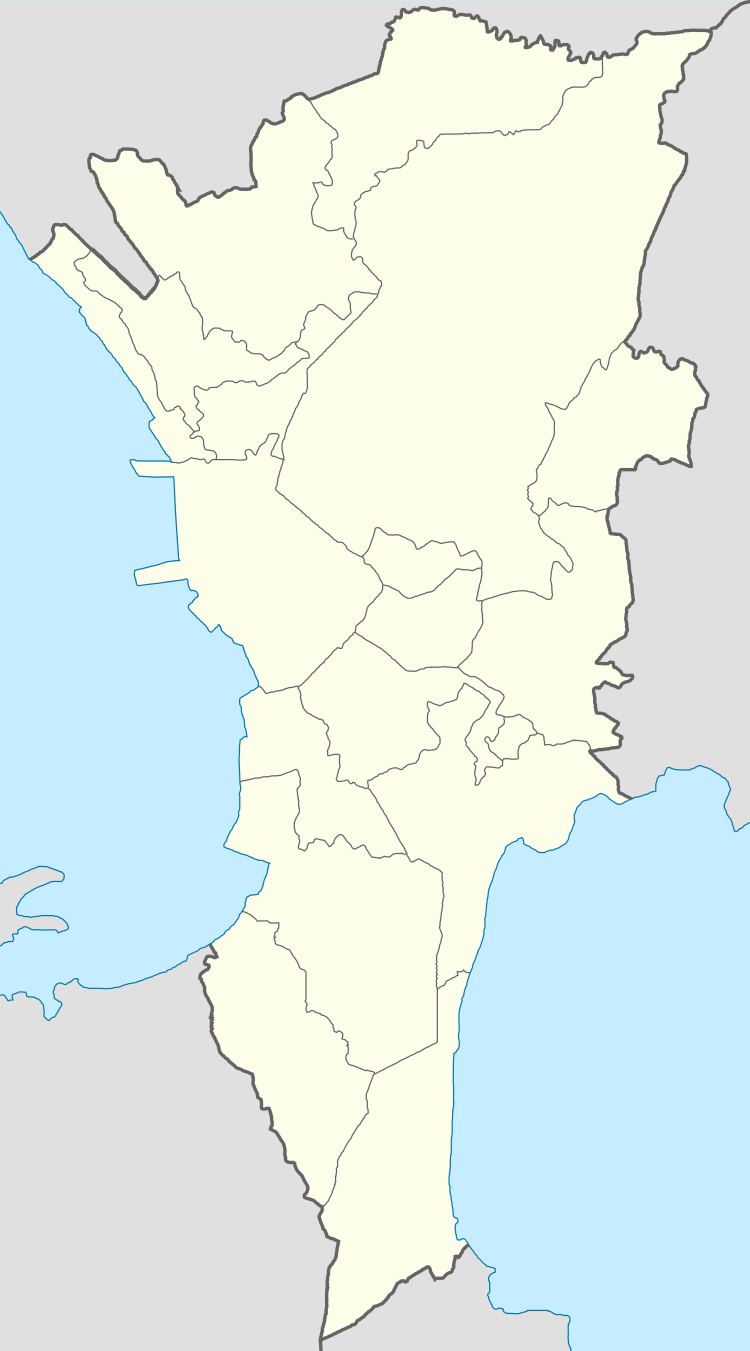Iglesia Filipina Independiente National Cathedral
| Iglesia Filipina Independiente National Cathedral | |
|---|---|
| Cathedral of the Holy Child | |
|
Facade of the Building | |
 Location in Metro Manila | |
| Basic information | |
| Location | Ermita, Manila |
| Geographic coordinates | 14°34′42″N 120°59′21″E / 14.578266°N 120.989282°ECoordinates: 14°34′42″N 120°59′21″E / 14.578266°N 120.989282°E |
| Affiliation | Philippine Independent Church |
| District | Ermita, Manila |
| Ecclesiastical or organizational status | Cathedral |
| Status | Active |
| Patron | Holy Infant Jesus |
| Website | http://ifinc.org/ |
| Architect(s) | Architect Carlos D. Arguelles |
| Groundbreaking | 1964 |
The Cathedral of the Holy Child, the National Cathedral of Philippine Independent Church, is the seat of the Obispo Maximo, its Chief Pastor and Spiritual Head, located in Ermita, Manila, Philippines. The National Cathedral was built in 1969 and dedicated to the honor of the Holy Infant Jesus, Patron Saint of Tondo, Manila. It replaced the first Cathedral in Tondo, Manila, which was completely destroyed during World War II.[1]
History
First Central Church
Iglesia Filipina Independiente's first Central Church was actually the ground floor of a big house located at 488 Calle Lemery (now Juan Luna Street), a few meters away from Paseo de Azcarraga, in Tondo, Manila. Doña Saturnina Salazar, mother-in-law of Don Felipe Buencamino, also known as the wealthy and grand old lady of Tondo, Manila, was the owner of the house. It was in the same house, on October 26, 1902, where the historic grand inauguration, launching and celebration of the first solemn high mass as Obispo Maximo of Most Rev. Isabelo de los Reyes, Jr. was held. After the historic event, Doña Saturnina also volunteered to finance the building of the National Cathedral in a lot she voluntarily donated to the church but without deed.
In January 1905, the blessing and inauguration of the National Cathedral happened. The Church, otherwise known as the Tondo Cathedral, stood in the more than 2,000 square meter lot at 227 (formerly No. 111) Calle Azcarraga (now Claro M. Recto Avenue), but was totally destroyed on February 6, 1945 by the indiscriminate bombing by the American forces during World War II. Rev. Padre Felix de la Cruz was assigned as the first priest of Tondo Cathedral. He served from 1905 until his death in 1907. Father Santiago Fonacier succeeded him.
With the destruction of the National Cathedral, gone too the church lot when it was recovered by the heirs of Doña Saturnina Salazar. For over twenty years, the church was without a national center of worship. While there were plans to build a National Cathedral after the war, yet the attention of the national leadership was diverted to solve the many internal problems besetting the church. The Maria Clara Christ Church at V. Concepcion Street in Santa Cruz, Manila served as the temporary national center of worship.[2]
Construction of the National Cathedral
On the occasion of the centenary of the birth of Bishop Gregorio Aglipay in 1960, a fund raising program was launched to build a National Cathedral on a lot in Ermita, Manila, owned by the American Episcopal Church, which the latter offered to the church. The lot has an area of 3,501.50 square meters where a big house used to stand and serve as the official residence of the Missionary Bishop of the Episcopal Church. The property was first leased to the church for a term of 99 years by virtue of a Lease Contract executed on February 25, 1966 between the Domestic and Foreign Missionary Society of the Protestant Episcopal Church in the United States of America and the Iglesia Filipina Independiente in consideration of the sum of four (4) pesos (P4.00). The Most Rev. Isabelo de los Reyes, Jr. (Obispo Maximo), and Most Rev. John E. Hines, respectively signed the Contract in a fitting ceremony held at Manila. In 1972, by virtue again of the said Contract, the Lessor Domestic and Foreign Missionary Society of the Protestant Episcopal Church in the United States of America voluntarily ceded and conveyed unto the Lessee Iglesia Filipina Independiente ownership in fee simple of the said property and all improvements thereon, subject, however, to certain conditions.
A groundbreaking and corner stone laying were held for the building of the National Cathedral on December 18, 1964. Since then, a massive nationwide fund raising campaign under the charismatic leadership of the Obispo Maximo, and spearheaded by the National Cathedral Commission, was done from among the members and symphatizers of the Church. The National Cathedral was designed by Architect Carlos D. Arguelles.
Coinciding with the 109th birth anniversary of the first Obispo Maximo, the National Cathedral was blessed and inaugurated on May 8, 1969. Thousands of faithful and several heads of national Catholic Churches and Protestant Churches throughout the world attended and joined the long procession from T. M. Kalaw Street to the site of the blessing and inauguration. The National Cathedral was dedicated to the Holy Infant Jesus, being the Patron Saint of the first National Cathedral in Tondo, Manila. Almost all major newspapers editorialized the historic occasion.
Bishop Soliman F. Ganno was appointed as the first Dean and he served from 1969 until 1970.
In 1973, by virtue of Motion 73-17 and following the recommendation of then Obispo Maximo, Most Rev. Macario V. Ga, the SCB approved that “the Cathedral of the Holy Child be autonomous and with independent Episcopal jurisdiction, having the same status of a Diocese, and, further, it shall enjoy full representation in the General Assembly of the Philippine Independent Church.”
The National Cathedral being the Holy See of the Obispo Maximo, hence, he episcopally administers it. At present, the Canon to the Obispo Maximo serves as the Dean.
References
- ↑ "About IFI National Cathedral". Facebook. Retrieved 4 April 2015.
- ↑ "History". Iglesia Filipina Independiente National Cathedral. Retrieved 4 April 2015.